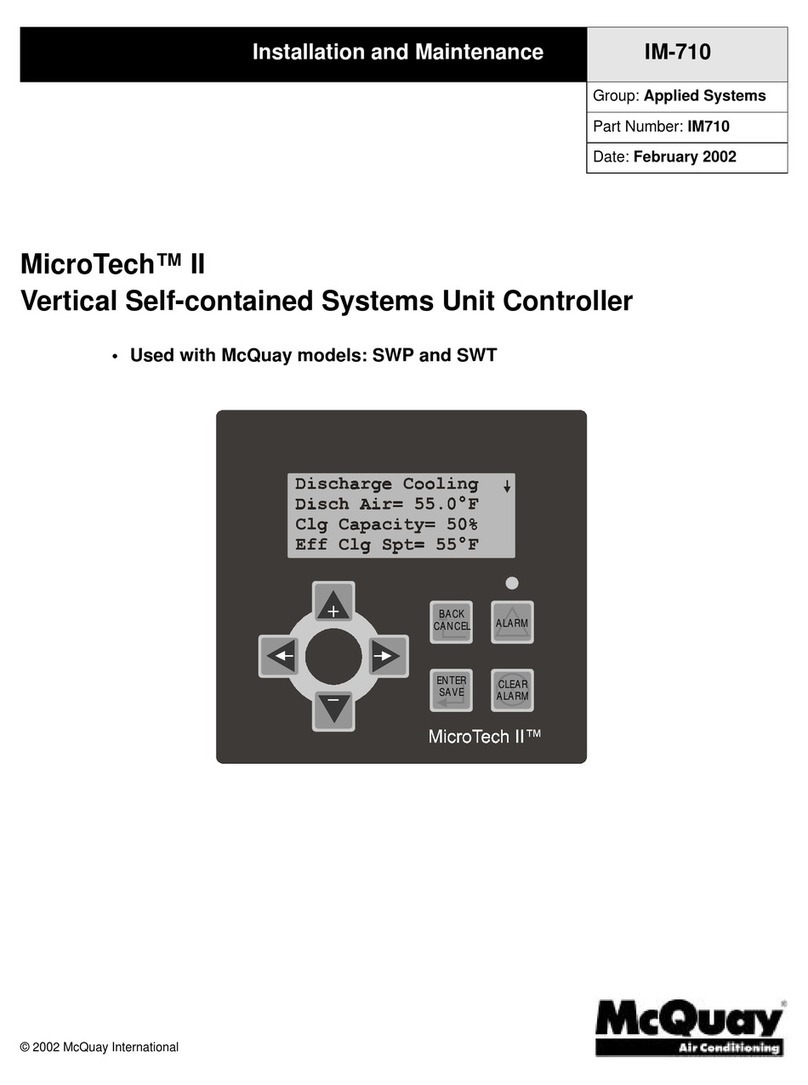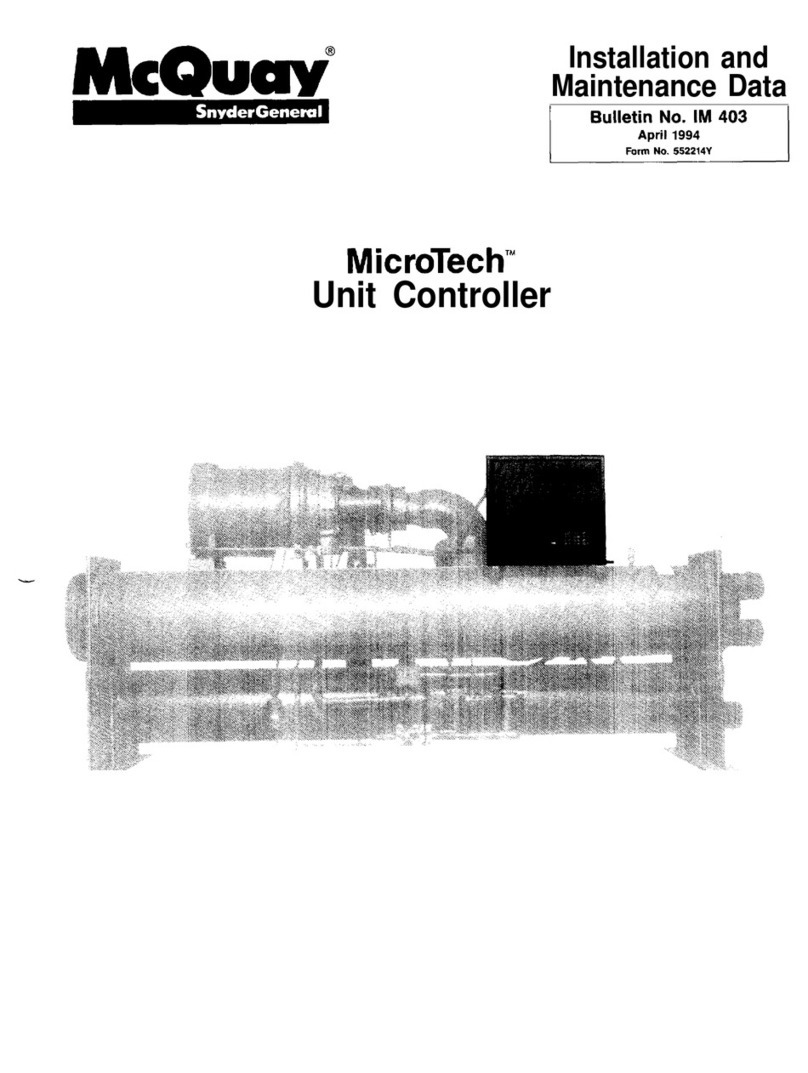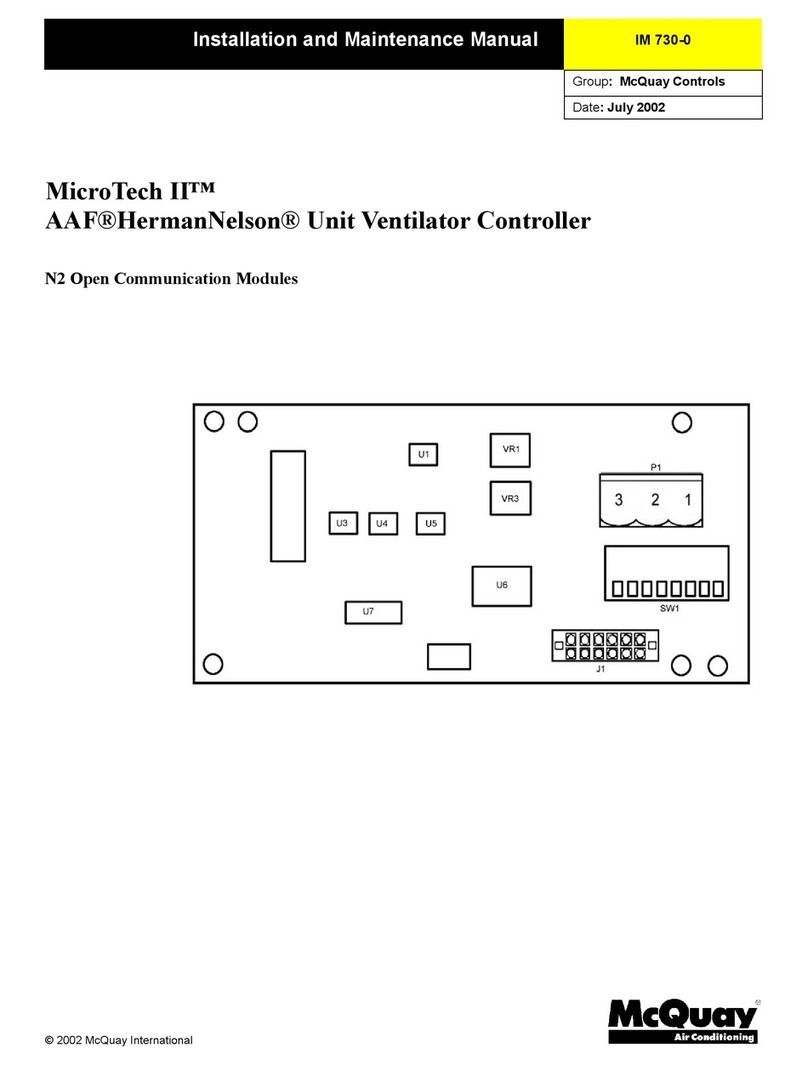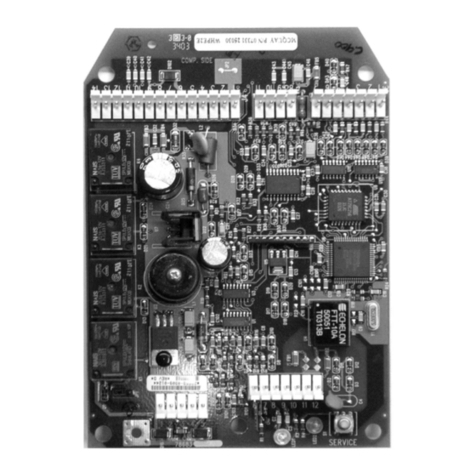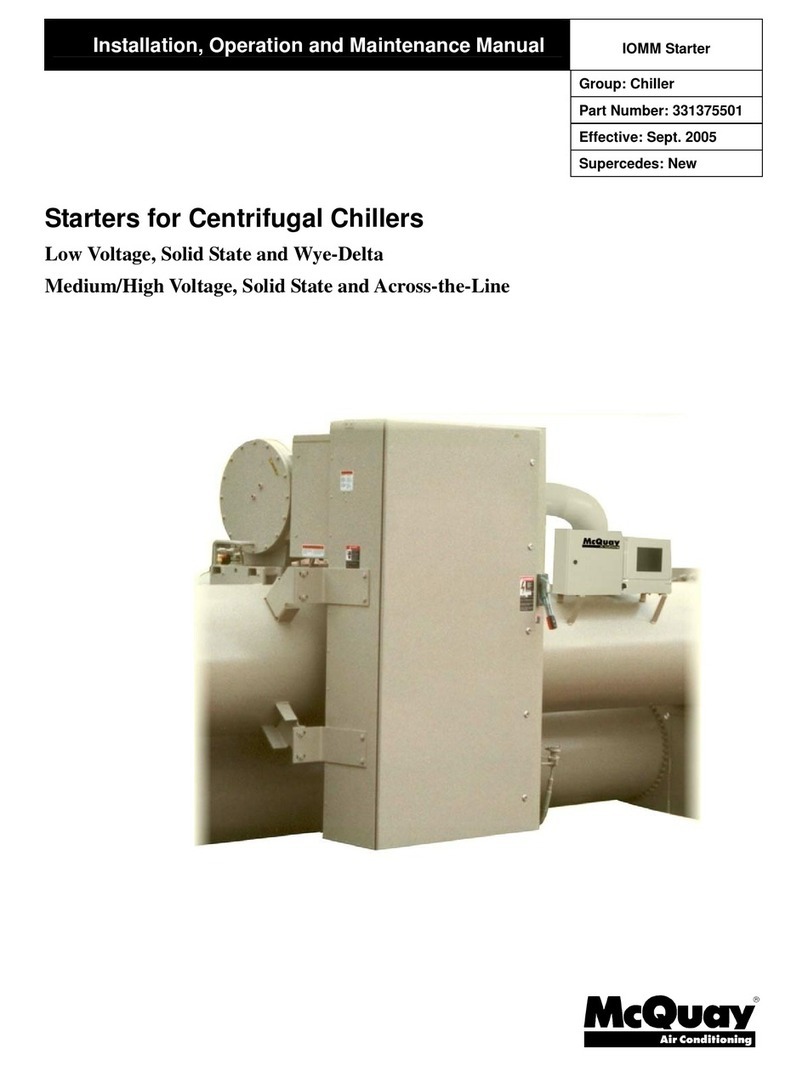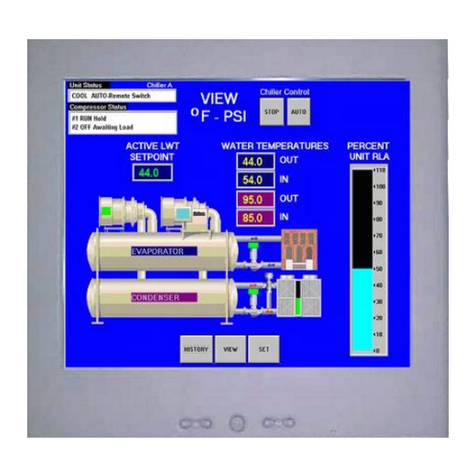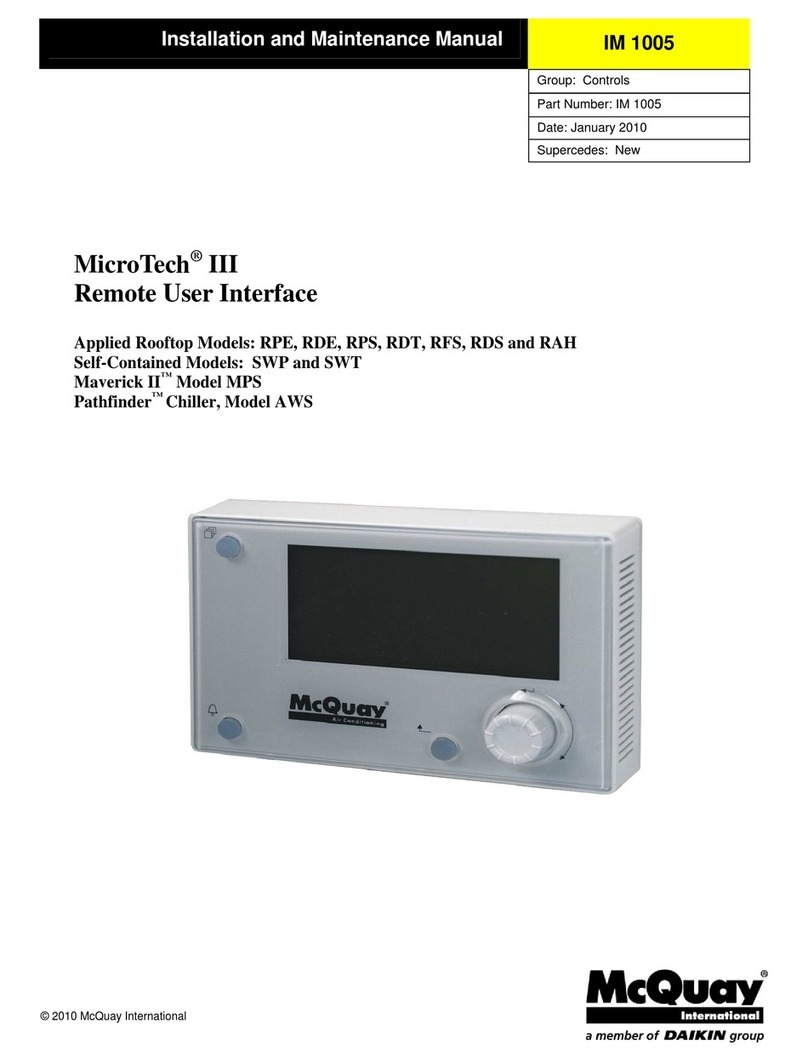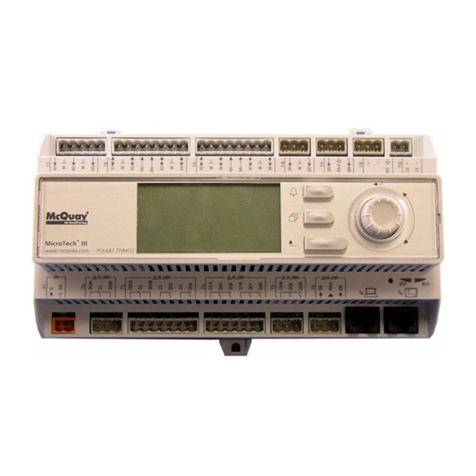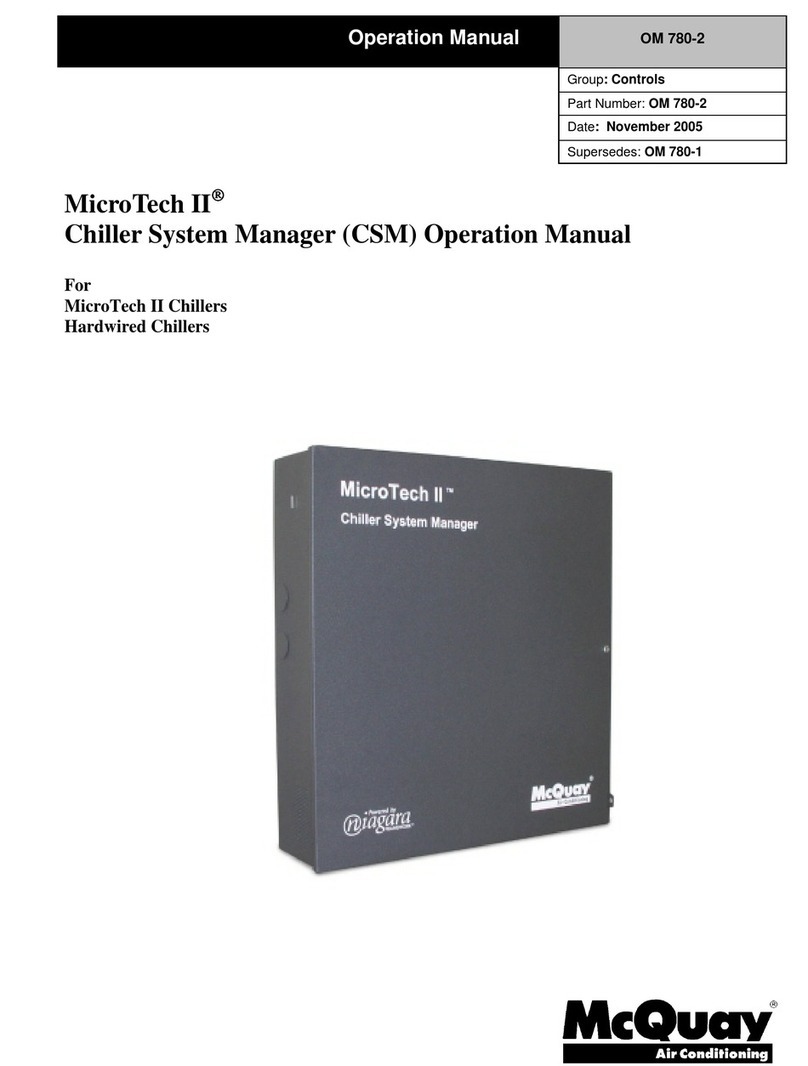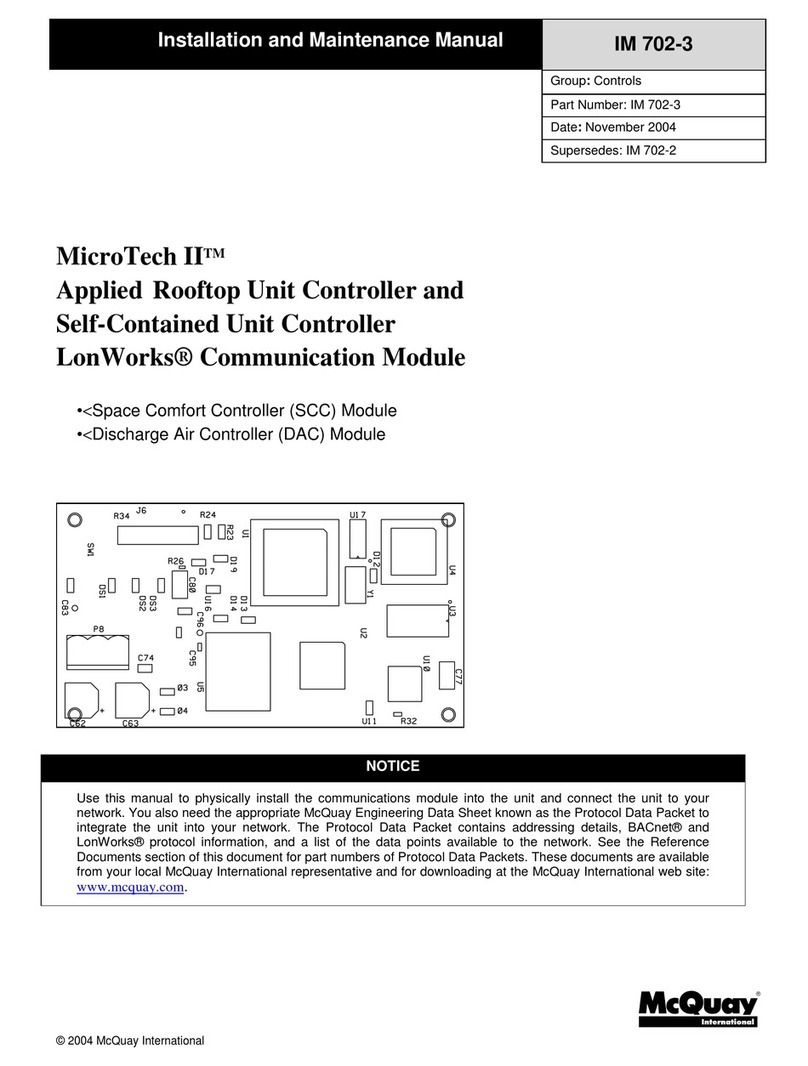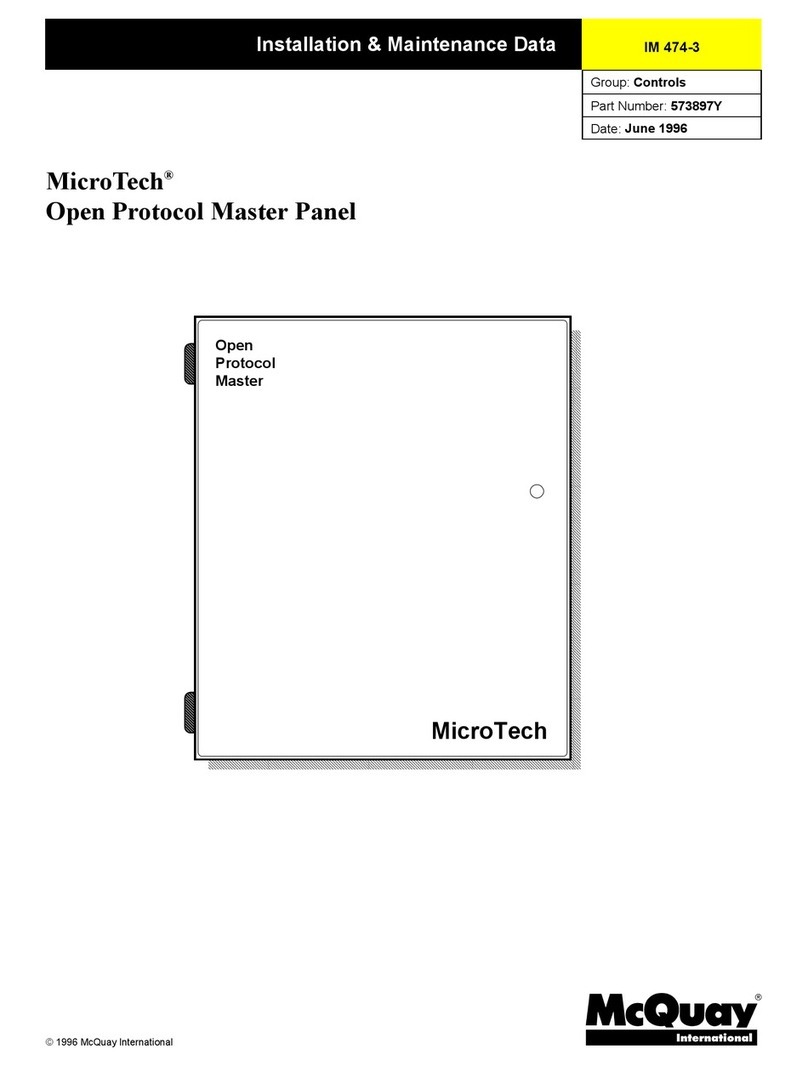
Contents
McQuay and MicroTech II are registered trademarks of McQuay International.
Microsoft is a registered trademark of Microsoft Corporation.
Windows is a trademark of Microsoft Corporation.
Copyright © 2004 McQuay International. All rights reserved throughout the world.
Introduction . . . . . . . . . . . . . . . . . . . . . . . . . . . . . . . . . . . . . . . 1
General Description . . . . . . . . . . . . . . . . . . . . . . . . . . . . . . . 2
Component Data . . . . . . . . . . . . . . . . . . . . . . . . . . . . . . . . . . . . . . . 2
Main Control Board (MCB) . . . . . . . . . . . . . . . . . . . . . . . . . . . 3
Analog inputs terminal blocks . . . . . . . . . . . . . . . . . . . . . 4
Binary Inputs Terminal Blocks . . . . . . . . . . . . . . . . . . . . . 4
Binary Outputs Terminal Blocks . . . . . . . . . . . . . . . . . . . 4
RS-485 Communications Terminal Block . . . . . . . . . . . . 4
Power Supply Terminals . . . . . . . . . . . . . . . . . . . . . . . . . 4
Keypad/LCD Display Connection . . . . . . . . . . . . . . . . . . 4
Communication Modules . . . . . . . . . . . . . . . . . . . . . . . . . . . . . 4
Plug-in BACnet/IP Communications Module . . . . . . . . . . 4
Plug-in BACnet MS/TP Communications Module . . . . . . 4
LonWorks® Communication Modules . . . . . . . . . . . . . . . 5
RS-232 Connection Port . . . . . . . . . . . . . . . . . . . . . . . . . 5
15 VDC Supply Connection . . . . . . . . . . . . . . . . . . . . . . . 5
Main Control Board LEDs . . . . . . . . . . . . . . . . . . . . . . . . 6
Auxiliary Control Boards (CCB1and CCB2) . . . . . . . . . . . . . . 6
Analog Inputs Terminal Block (J8) . . . . . . . . . . . . . . . . . 7
Binary Inputs Terminal Blocks (J9 and J10) . . . . . . . . . . 7
Binary Outputs Terminal Block . . . . . . . . . . . . . . . . . . . . 8
RS-485 Communications Module . . . . . . . . . . . . . . . . . . 8
Power Supply Terminals (J1) . . . . . . . . . . . . . . . . . . . . . 8
J7 Terminal Block . . . . . . . . . . . . . . . . . . . . . . . . . . . . . . 8
J2 Terminal Block . . . . . . . . . . . . . . . . . . . . . . . . . . . . . . 8
Main Control Board (MCB) Output Relays and Triacs . . . . . . 8
Auxiliary Control Boards (CCB1 and CCB2) Output Relays . . 8
Keypad/Display . . . . . . . . . . . . . . . . . . . . . . . . . . . . . . . . . . . . 8
Temperature Sensors . . . . . . . . . . . . . . . . . . . . . . . . . . . . . . . 9
Pressure Transducers . . . . . . . . . . . . . . . . . . . . . . . . . . . . . . . 9
Humidity Sensors . . . . . . . . . . . . . . . . . . . . . . . . . . . . . . . . . . 9
Actuators . . . . . . . . . . . . . . . . . . . . . . . . . . . . . . . . . . . . . . . . . 9
Adjustable Frequency Drives (AFDs) . . . . . . . . . . . . . . . . . . . 9
Field Wiring . . . . . . . . . . . . . . . . . . . . . . . . . . . . . . . . . . . . . . . 10
Field Output Signals . . . . . . . . . . . . . . . . . . . . . . . . . . . . . . . . . . . 10
Outside Air Damper . . . . . . . . . . . . . . . . . . . . . . . . . . . . . . . . 10
Fan Operation Output . . . . . . . . . . . . . . . . . . . . . . . . . . . . . . 10
Remote Alarm Output . . . . . . . . . . . . . . . . . . . . . . . . . . . . . . 10
VAV Box Output . . . . . . . . . . . . . . . . . . . . . . . . . . . . . . . . . . 11
Cooling-Only Units . . . . . . . . . . . . . . . . . . . . . . . . . . . . 11
Cooling-Only Units With Field Supplied Heat . . . . . . . . 11
Units With Staged Heat . . . . . . . . . . . . . . . . . . . . . . . . . 11
Units With Modulating Heat . . . . . . . . . . . . . . . . . . . . . . 12
Pump Start Output . . . . . . . . . . . . . . . . . . . . . . . . . . . . . . . . . 12
Field Analog Input Signals . . . . . . . . . . . . . . . . . . . . . . . . . . . . . . . 12
Zone Temperature Sensor Packages . . . . . . . . . . . . . . . . . . 12
Zone Sensor Without Remote Setpoint Adjustment . . . 12
Zone Sensor With Remote Setpoint Adjustment . . . . . . 12
Tenant Override (Timed) . . . . . . . . . . . . . . . . . . . . . . . . . . . . 13
External Discharge Air Reset Signal . . . . . . . . . . . . . . . . . . . 13
Field Actuator Feedback . . . . . . . . . . . . . . . . . . . . . . . . . . . . 14
Field 100% OA Damper Actuator . . . . . . . . . . . . . . . . . . . . . 14
Humidity Sensors . . . . . . . . . . . . . . . . . . . . . . . . . . . . . . . . . 15
Humidity sensor—discharge air control (DAC) unit . . . . 15
Field Binary Input Signals . . . . . . . . . . . . . . . . . . . . . . . . . . . . . . . 16
Manual Cooling And Heating Enable . . . . . . . . . . . . . . . . . . 16
Cooling Enable . . . . . . . . . . . . . . . . . . . . . . . . . . . . . . . 16
Heating Enable . . . . . . . . . . . . . . . . . . . . . . . . . . . . . . . 16
Manual Unit Enable . . . . . . . . . . . . . . . . . . . . . . . . . . . . . . . . 16
External Time Clock Or Tenant Override . . . . . . . . . . . . . . . . 16
Miscellaneous Output Signals . . . . . . . . . . . . . . . . . . . . . . . . 16
Service Information . . . . . . . . . . . . . . . . . . . . . . . . . . . . . . . 17
Controller Inputs . . . . . . . . . . . . . . . . . . . . . . . . . . . . . . . . . . . . . . . 17
Analog Inputs—Main Control Board (MCB) . . . . . . . . . . . . . . 17
Analog inputs—Auxiliary Control Boards (CCB1 and CCB2) 19
Binary Inputs—Main Control Board (MCB) . . . . . . . . . . . . . . 19
Binary Inputs—Auxiliary Control Boards (CCB1 and CCB2) . 19
CCB1 and CCB2 . . . . . . . . . . . . . . . . . . . . . . . . . . . . . . 20
Controller Outputs . . . . . . . . . . . . . . . . . . . . . . . . . . . . . . . . . . . . . 21
Binary Outputs—Main Control Board (MCB) . . . . . . . . . . . . . 21
Binary Outputs—Auxiliary Control Boards (CCB1 and CCB2) .
22
CCB1 & CCB2 . . . . . . . . . . . . . . . . . . . . . . . . . . . . . . . . 22
2 Compressors—2 Stages . . . . . . . . . . . . . . . . . . . . . . . . . . . 22
3 Compressors—3 Stages . . . . . . . . . . . . . . . . . . . . . . . . . . . 23
4 Compressors—4 Stages . . . . . . . . . . . . . . . . . . . . . . . . . . . 23
3 Small Compressors & 1 Large Compressor—5 Stages . . . 23
2 Small Compressors & 2 Large Compressors—6 Stages . . 23
6 Compressors—6 Stages . . . . . . . . . . . . . . . . . . . . . . . . . . . 24
Software Identification and Configuration . . . . . . . . 25
Main Control Board (MCB) Configuration . . . . . . . . . . . . . . . . . . . 25
Main Control Board (MCB) Data Archiving . . . . . . . . . . . . . . . . . . 26
Keypad/Display Objects . . . . . . . . . . . . . . . . . . . . . . . . . . . . . . . . . 26
Typical Wiring Diagrams . . . . . . . . . . . . . . . . . . . . . . . . . 27
Test Procedures . . . . . . . . . . . . . . . . . . . . . . . . . . . . . . . . . . 35
Troubleshooting Main Control Board (MCB) . . . . . . . . . . . . . 35
MCB Battery . . . . . . . . . . . . . . . . . . . . . . . . . . . . . . . . . . 35
MCB Data Archiving . . . . . . . . . . . . . . . . . . . . . . . . . . . . 35
MCB “Cold” Reboot . . . . . . . . . . . . . . . . . . . . . . . . . . . . 35
MCB LED Power-Up Sequence . . . . . . . . . . . . . . . . . . . 36
MCB LED Startup Error Codes . . . . . . . . . . . . . . . . . . . 37
Battery Test . . . . . . . . . . . . . . . . . . . . . . . . . . . . . . . . . . 38
Flash CRC Tests . . . . . . . . . . . . . . . . . . . . . . . . . . . . . . 38
SRAM Test . . . . . . . . . . . . . . . . . . . . . . . . . . . . . . . . . . . . . . . 39
Communication Port Tests . . . . . . . . . . . . . . . . . . . . . . . 39
IP Register Test . . . . . . . . . . . . . . . . . . . . . . . . . . . . . . . 39
Troubleshooting Auxiliary Control Boards (CCB1and CCB2) 39
Hardware Check . . . . . . . . . . . . . . . . . . . . . . . . . . . . . . 39
RS-485 Communication Module Status LEDs . . . . . . . . 39
Troubleshooting Keypad/Display . . . . . . . . . . . . . . . . . . . . . . . . . . 40
Keypad/Display Power Up Initialization . . . . . . . . . . . . . 40
Troubleshooting Temperature Sensors . . . . . . . . . . . . . . . . . 41
. . . . . . . . . . . . . . . . . . . . . . . . . . . . . . . . . . . . . . . . . . . . . . . . 41
Troubleshooting Communications Cards . . . . . . . . . . . . . . . . 41
BACnet/IP Module . . . . . . . . . . . . . . . . . . . . . . . . . . . . . 42
BACnet MS/TP Module . . . . . . . . . . . . . . . . . . . . . . . . . 42
LonMark Module . . . . . . . . . . . . . . . . . . . . . . . . . . . . . . 42
Troubleshooting Static Pressure Transducers . . . . . . . . . . . . 42
Troubleshooting Refrigerant Pressure Transducers . . . . . . . 44
Parts List . . . . . . . . . . . . . . . . . . . . . . . . . . . . . . . . . . . . . . . . . 45
